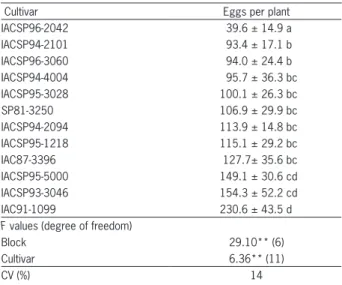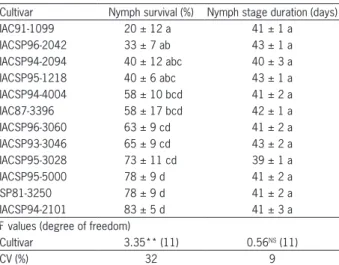Resistance mechanisms of sugarcane cultivars to spittlebug Mahanarva fimbriolata
Texto
Imagem




Documentos relacionados
anisopliae (Metschnikoff) Sorokin isolates in controlling the sugarcane root spittlebug Mahanarva fimbriolata (Stal) (Hemiptera: Cercopidae), nine isolates obtained
Nymphal period (days), longevity (days) of males and females of the root spittlebug, Mahanarva fimbriolata in sugarcane, treated with aqueous extract of Anacardium humile
photoperiod) to carry out laboratory tests to evaluate adult feeding and female oviposition preferences (using both free-choice and no-choice tests) as well as the effects of
ABSTRACT: The sugarcane spittlebug, Mahanarva fimbriolata (Walker) (Hemiptera: Cercopidae) is an economically important pest of sugarcane in Brazil. The purpose of this study was to
Assim, tendo em vista a importância do alei- tamento materno para o binômio mãe-filho, e pela importância de se conhecer a realidade com vista em planejamentos de ações destinadas a
Desta forma, diante da importância do tema para a saúde pública, delineou-se como objetivos do es- tudo identificar, entre pessoas com hipertensão arterial, os
An analysis of the retrospective cohort of all renal transplants performed at Botucatu Medical School University Hospital between June 17, 1987, when the first renal transplant
However, since the same number of eggs was laid on each plant, the largest number of biological forms was found in cultivars IACSP96-3060 and IACSP94-4004, but not